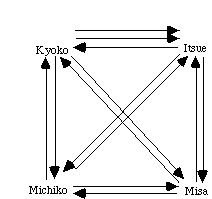QUICK GUIDE
Key Words: Speak, Observation, Awareness
Learner English Level: Intermediate
Learner Maturity Level: First year college
Preparation Time: An hour or less
Activity Time: Ninety minutes
This speaking exercise is a group activity which encourages equal participation from all members. It gives students an opportunity to talk, to observe and to listen. It provides a visual tool useful for feedback and self-awareness without videotaping. Students record their observations and opinions and can refer to their notes later for self-evaluation. Simple variations will help modify the level of difficulty of the exercise.
Objectives
The students will:
(1) observe and record the flow of conversations.
(2) participate actively and spontaneously in social conversations.
(3) record their thoughts regarding their behavior .
(4) record their performance.
Preparation and Set-up
Write five to ten statements on small cards. Examples of statements are "last week-end," "next April," "my good habit," "I went to," or "a year ago." Divide the class into groups of five or six people. Give each group a set of small cards. Spread the cards upside-down on a small desk around which students sit in a circle. Each group should have paper, pencils and watches.
Brief Lecture
Some groups may require a short lecture reminding students that English social conversations require stimulating responses from participants and very little silence. Also various topics may emerge even though they are not directly linked to each other. The analogy of the tennis ball from the book Polite Fictions by Sakamoto and Naotsuka can be useful in providing an image of an animated English conversation.
Procedure (many variations are possible)
(1) Ask the group to choose their first speaker and a recorder for the first round. Other students will be listeners and responders.
(2) Explain the activity: The first speaker picks a card, reads the statement out loud and starts talking about the selected topic. Everyone else listens actively. First speakers talk as long as they want and when they cease talking, all listeners must respond to the first speaker's ideas by sharing opinions, developing ideas, or asking questions related to what has been expressed. Turns for responding are not determined; the more statements the better and each student must talk at least once before the round can be completed. Short periods of silence are acceptable, but initiative and spontaneity are greatly expected. The Japanese language cannot be used.
Recorders do not talk at all. First, they write the participants' names on a piece of paper, showing the seating location of each student and recording the time when the conversation begins. The recorder's major responsibility is to draw a picture of the flow of conversations with arrows indicating the number of statements and their directions, as in the diagram below.
Sample Picture of a Conversation
Date: May 23, 1996 First round: start-1:15 end-1:22 Total of statements: 13 statements

The recorder also signals the completion of the round. The round ends if a long silence (30 seconds) occurs and everyone has spoken at least once. At the end of a round, the time is recorded again as well as the total number of interruptions that took place. Roles change and a new round commences. When each student has been a recorder once, the activity ends. By that time, each group has five or six paper recordings of their conversations.
The figure above shows how many times each person initiated a response, who the immediate responders were, and how lively and balanced the seven-minute conversation was.
(3) Ask students to look at each sheet carefully. Each of them must record in their English notebook the length of each conversation, the total number of arrows and the number of times they personally interacted. So, according to the figure above, Kyoko would write "13 statements took place in the first round which lasted 7 minutes, and I initiated statements four times." Then ask them to take a new sheet and write their thoughts, their observations, and findings from the drawings. Gather all sheets and compile comments to give students at the next lesson. Here are a few of the common points mentioned by students:
- I liked being an observer because everyone was enjoying the conversation
- Kyoko and Makiko did not talk a lot but Itsue and Megumi talked a lot
- Everyone talked but the conversation was mostly between two people
- Shy people did not talk much but were interested.
- Three people talked about the earthquake
- Everyone talked about the same amount of time.
-
Everyone wished to talk and everyone could talk
- My group members said "Oh" many times; there was too much "Katakana" words
- We need to practice more, but we know more English than we think
- When I as an observer, I wanted to speak
- At first nobody could say much but eventually everyone was talking a lot
Suggestions and Variations
The teacher can benefit from keeping records that can be referred to when evaluating progress and doing further planning. Repeated a few times throughout the year, the activity allows students to realize if they are participating more or less in conversations. The difficulty of the speaking activity can increase with some variations such as bringing up topics of discussion without cards. Also, grammatical practice is possible if statements focus on themes related to the past, for example. Students can learn to set personal goals for improvement. The whole process involving groups of five or six people in a class of 30 requires about 90 minutes. At least 15-20 minutes should be allowed for students to write their thoughts. Also the list of students' comments can be a subject for discussion in class for increasing awareness in general students' tendencies.


